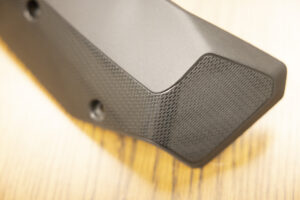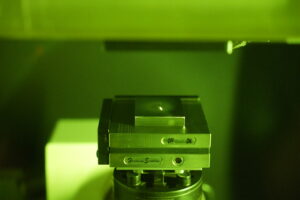Pulse Technology and Software Power Laser Machining Popularity
There is a direct relationship between laser machining and texturing capabilities and the manufacturing market’s demand for it. The more capacity, effectiveness and efficiency the technology gains, the more ways it will be industrialized and integrated into everyday use.
Posted: December 8, 2023

Part processes involving the use of lasers for texturing, blasting, machining, structuring and engraving are rapidly gaining in popularity, moving from the perimeter to mainstream advanced manufacturing. This is particularly true when applications require micron-scale ultra-high precision and finishes.
While one can debate whether technological advance drives demand or vice versa, it’s clear that the evolution in laser sources/pulse technology and software control have moved laser manufacturing technology to the tip of the spear. In the past decade, the industry, in particular, has seen dramatic strides in laser source innovation.
For instance, nanosecond fiber pulsed lasers used a 100-nanosecond pulse to deposit heat into a material to create ablation. The intersection of heat and its affected zone, concentrated energy and material removal has been the critical juncture of laser manufacturing viability.
Today’s generation of nanosecond lasers can vary pulse duration from two to 500 nanoseconds, allowing long pulses to ablate quickly followed by short bursts to improve surface quality and finish. The challenge has always been how to deposit sufficient energy for clean ablation while simultaneously preventing the creation of a heat affected zone (HAZ) that mars surface finishes and precision.

To overcome that challenge, laser system OEMs developed sources that produce faster, ultrashort pulsing lasers in the picosecond and femtosecond range. Those refinements improve reliability sufficiently to make the process feasible. For reference, a nanosecond pulse lasts one-billionth of a second; a picosecond pulse occurs in a trillionth of a second, and femtosecond is 1,000 times shorter than a picosecond.
Even the shorter duration picosecond lasers produce a HAZ, which is unacceptable in certain high-precision medical and aerospace applications. As a result, and to move the application as far forward as possible, GF Machining Solutions bypassed picosecond laser sources, opting to develop femtosecond lasers with OEM Flexipulse technology that allows the tool to vary the pulse duration and simulate the entire laser bandwidth on one machine.
With femtosecond technology, the pulse duration is so short there’s no time to deposit heat into the surrounding material, thereby, eliminating the HAZ. Instead, “cold ablation” occurs by breaking bonds at the molecular level instead of relying on thermal energy to melt material.
Pairing femto-pulse capability with variable pulse duration gives manufacturers the flexibility to accommodate virtually any job without sacrificing precision. Additionally, laser source advancements to the femtosecond level along with refinements to the laser beam itself allow manufacturers to go from raw material to finished part without the need for secondary finishing processes.
When it comes to part processing versatility, these advanced ultrashort pulse laser sources provide the ability to texture new materials that were previously challenging or impossible to work with. These include light-absorbing materials such as graphite and reflective surfaces found on copper, glass and translucent materials.
In addition to the exceptional breakthroughs in laser source development, software and control functions have been improved to cut production from days to hours. Previously, shops would spend days writing a program for an hour’s worth of laser striking. That type of labor-intensive process to complete a complicated texturing pattern made laser too inefficient as a technical manufacturing solution.
In the fall of 2022, GF Machining Solutions released the latest version of its laser texturing, engraving and micromachining CAM software, LaserDesignä, that includes two new features, FlexiBlastä and 3DCurvesä. FlexiBlast allows users to produce high-definition, photo-realistic images with increased depth perception on virtually any material.
The 3DCurves feature offers a novel approach to the design of fine line textures and patterns. It allows users to engrave high-precision line textures directly with a single continuous laser path without using a hatching process based on a grayscale bitmap image that is limited by its resolution. The software enables the generation of 2D designs using GF Machining Solutions’ LASER P laser texturing machines and the ability to texture curves virtually on complex 3D parts and molds using the company’s laser machines.
Additional software developments like GF’s patented Smartpatch technology randomize the patching of texture design segments. This makes the lasered patterns uniform and free of any indication where one section ends and another begins. Software and control development have made it easier than it has ever been in the last decade to generate complex, five-axis textures on contoured parts and mold shapes and allow manufacturers to enter the laser part processing field.
As a result of the new software sophistication, beam control, machine speed, and performance have been improved. The bottom line: machines are running quicker from job to job, and manufacturers are reducing the time it takes to produce their designs.
In addition to pulse technology along with software and control functions, market demand and customer needs have also proven a catalyst in laser manufacturing development. In most cases that centers around new product innovation and designs that require manufacturing methods beyond the conventional.
For example, the transition from sealed beam and xenon lamps to LED headlights for automobiles drove the need for generating microscopic details on headlight cover molds for better light dispersion. In such instances, laser technology is the only cost-effective process available to provide such precision. Similarly, as micro-machining becomes more commonplace, manufacturers, especially those in the medical industry, need tools that can efficiently produce molds and components in finished form without secondary post-processing.
There is a direct relationship between laser machining and texturing capabilities and the manufacturing market’s demand for it. The more capacity, effectiveness and efficiency the technology gains, the more ways it will be industrialized and integrated into everyday use. What was a benchmark 10 years ago, is now seen as baseline, and today’s standards are surely only precursors of what’s to come in the future.







